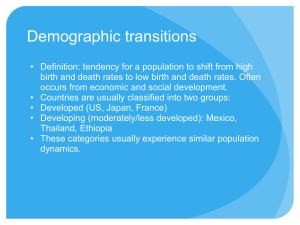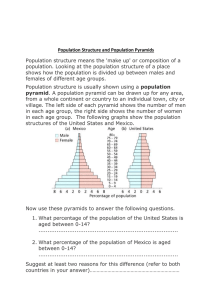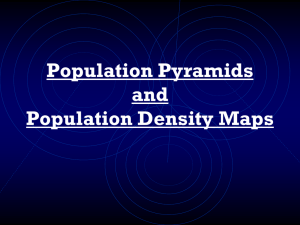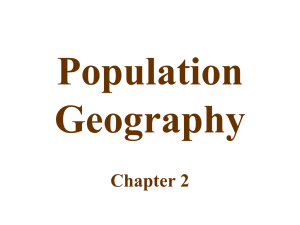Population Geography
advertisement
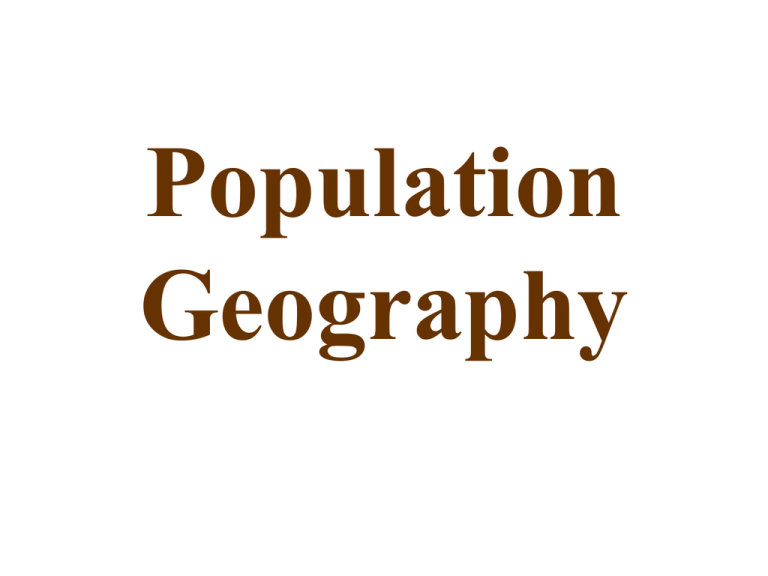
Population Geography Population • Demographics is the study of human population distribution and migration. • Key Issues of Demographics are: – Food Supply – Health and life expectancy – Status of women – Migration People are NOT distributed evenly across the Earth. Population is clustered in the mid latitude climates and relatively sparse in the dry and polar climates or the highlands. • Density-the measure of the number of people per square mile/kilometer, etc. • Distribution- ¾ of the world’s population lives on only 5% of the land. Very uneven distribution was intensified in the 20th cent. as population soared. 2/3 of the pop. lives near an ocean or river. • Carrying capacity-the number of people that can be supported in an area given the technology of production. World Population Density World Population Cartogram Countries named have at least 50 million Birth and Death Rates ●Birth and death rates refer to how many people are born and how many people die. Developing countries have high death rates and birth rates. Birth and Death Rates ●Birth rates are higher in developing countries for the following reasons: 1.No birth control 2.Religious restrictions 3.Economic factors 4.The role of women in society Birth and Death Rates ●Death rates are higher in developing countries for the following reasons: 1.No access to medical care 2.Poor nutrition Population Clock Population Growth • From Dawn of History to 1820 to reach 1 billion • 1820-1930 to reach 2 billion • 1970s only 12 years to add another billion. • Then a decade for another billion. • 80 million people added to the world pop. each year. • Demographers estimate growth will stabilize in the 21st cent. Geography of Demography • India has explosive growth in Assam (northeast) & those states that border Bangladesh on the GangesBrahmaputra Basin. • India will overtake China as the most population nation-1.9% growth with 18 m. added each year. • Population planning began in the 1950s with little money. • 1960s more serious efforts Geography of Demography • State of Maharashatra planned to sterilize anyone with over 3 children-a riot erupted-plan was dropped. • Today advertising to encourage families to have fewer children-a low key, noncompulsory approach. • Some Indian states have over 100 m. more than many countries • Religious diversity makes a national population policy difficult Maharashtra, India. A sign reads “free family planning sterlization operation” closed in 1996. World Birth Rate – number of births in a year per 1,000 people. World Death Rate – number of deaths in a year per 1,000 people. • Death rate-the number of deaths per 1,000 each year. • Birth rate-the number of births per 1,000 each year. • Fertility Rate the number of children born to women of childbearing age-usually reported as a percentage. • Dependency ratio-the number of people who are too young or too old to work compared to the number of people old enough to work. Crude Death Rates Fertility Rate of 2.1 to 2.5 children per woman is considered “replacement level.” Infant Mortality Rate • The amount of children that die in a given year. What is the relationship between money in a country and its infant mortality rate? Literacy Rates • The amount of people that can read and write in a country • May vary with gender. World Literacy Rates Women’s Literacy Rates Population Pyramids – Charts that show the percentages of each age group in the total population, divided by gender. For poorer countries, the chart is shaped like a pyramid. Infant mortality rates are high, life expectancy is shorter. Population Pyramid Analysis • Age – Tells how many people of a given age are alive in a country • Gender – a population pyramid gives the sex ratio of the country • Socioeconomic Status (SES) – Rich and poor countries have vastly different population pyramids • Population Pyramidsdisplay a country’s population in a bar graph form. • Each 5 year group with the youngest 0-4 years old at the base of the pyramid are called cohorts. • Males are shown on the left side and females are shown on the right. • A wide-based pyramid indicates a country in Stage 2 of the Demographic transition. Population Pyramids Charts that show the percentages of each age group in the total population, divided by gender. For wealthier countries, the chart is shaped like a lopsided vase. Population is aging, TFRs are declining. • Four Patterns of Population Structure • Each nation faces different problems due to a large base with many young or negative growth. In poorer countries, Infant Mortality Rates are usually high, which is reflected in the pyramid shape. In poorer countries, Life Expectancy is usually shorter, which is also reflected in the pyramid shape. Affect of AIDS on population pyramid for South Africa. Predicted population for 2035, without and with AIDS. With AIDS, looks like a population “chimney.” AIDS is leaving large numbers of AIDS orphans. • 1995 Population Pyramids reflect the economic prosperity of Western Europe and the less developed countries of Sub-Saharan Africa. In the mid-1990s almost 50% of Africa’s population was under 15 years of age. • By contrast the number of people 65 and older in Western Europe is 5 times that of sub-Saharan Africa. Age Structure of a Population • The populations of many countries are aging. - eg. Europe - eg. Japan Bordeaux, France Population Policies • Under Mao, China refused to cooperate in pop. Controlviewed it as a “capitalist plot” • Soviets in 1970s promoted population growth due to the loss of 26 million in WWII, Stalin exterminated another 30 million farmers, political opponents, etc.-gave awards for women with 10 or more kids. • US Reagan, a conservative, refused to support family planning Communist Medals • Pronatalist Policy • Awarded to mothers with more than 10 children. Population Policies • Expansive Policies or ProNatalist policies encourage large families e.g. Fascist Italy, Nazi Germany, Soviet Union & Ceausescu’s Romania & Mao’s China. • Eugenic Population Policy-Nazi Germany favored “Aryans” over mentally ill or other undesirables. • The Nazis tried to breed the super race of Nordic or Aryan types. Geography of Demography • Mao Zedong encouraged population growth-after his death Deng Xiaping called for control • 1979 launched the One Child Policy with goal of stabilizing at 1.2 billion by end of 20th cent. • 1970s growth rate 2.4% • 1985 growth rate 1.1% • After 1982 more serious enforcement-mandatory contraception after 1st child. • If a 2nd child was born-parents were sterilized. China’s One Child Policy What are some of the limitations, unintended consequences, and contradictions found in government policies toward population growth? Geography of Demography • First 6 years 70 million abortions • 1980s about 20 million sterilizations a year-3X as many women as men. • Party Members were birth control police-got cash and promotion for enforcing the laws. • 1984 One Child Policy was relaxed in the countryside-a couple with a daughter-2nd child after 4 years. Geography of Demography • Corruption a major problempermitted to evade rule-bribe. • Fertility rates are rising as the rules are relaxed. • One Child Policy was practical-but rural tradition opposed the rule • Drive for Zero Population Growth eroded the traditions of Chinese society. • Female infanticide a common occurrence. Geography of Demography • China’s One-Child Policy created a generation of 90 million • 119 boys for every 100 girls • 30 million unmarried men by 2020 • 45% of Chinese women said they don’t intend to wed. • 3/10 families have grandparents living with them • Biggest demographic revolution in history-Number of Elderly is rising-by 2050 about 30% of the population will be over 60-no pensions or social security.

